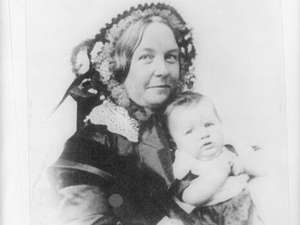ELIZABETH CADY STANTON: FEMINIST, WIFE AND MOTHER OF SEVEN

When her seventh child, Henry, was born in 1859, early feminist Elizabeth Cady Stanton raised a flag in front of her home–scandalizing the Seneca Falls, N.Y., community by her public celebration of motherhood.
The mid-19th century was a time when pregnancy and birth were still surrounded with silence and secrecy. It was an era during which women frequently remained out of public view throughout their “confinement” of pregnancy. They emerged after a few months with
(surprise!) a new family member who was received with little fanfare. Even in their diaries, women rarely mentioned their pregnancies, only briefly announcing the arrival of children as if they were good harvests. Women like Stanton were the exception. Her public flag-waving aptly symbolized the importance she placed on motherhood and gave her critics reason to distrust her for more than her women’s rights advocacy.
Even in her letters, Stanton celebrated her children’s births. Writing to her cousin Elizabeth Susan Miller at the birth of her fourth child (Feb. 10, 1851): “Laugh in your turn. I have actually got my fourth son. Yes, Theodore Weld Stanton after two long mighty flourishes of his royal crown bounded upon the stage of life, with great ease comparatively! I was sick but a few hours, did not lie down half an hour before he was born, but worked round as hard as I could all night to do up the last things I had to do.”
The letter announcing the birth of her daughter, Harriet (Oct. 22, 1852), to Lucretia Mott, who helped her organize the first Women’s Rights Convention in 1848: “I am at length the happy mother of a daughter. Rejoice with me all Womankind for lo! A champion of thy cause is born.” Later in the same letter, Stanton says: “When the child was 20 hours old I took a sponge bath, a sitz bath, put on a wet bandage, and then walked out on the piazza, and the day being I fine I took a drive on the plank road of three miles.”
Stanton had been raising eyebrows in Seneca Falls since her arrival in 1848, when she moved to the rural upstate village from Boston. Isolated from the social reform activities of the larger city where she spent the first years of her marriage, Stanton adored motherhood but was frustrated. The move plunged her into domesticity often marked by the difficulties of being a single mother whose minister husband traveled. She found herself left with the sole responsibility for home and three young sons more frequently than she wished, and her family eventually grew to seven children.
Throughout her life Stanton had to make choices between her work on behalf of women and her family obligations. Probably because she passionately endorsed woman’s role as mother, she did not compromise her own position as mother. During her children’s youth, from about 1843 to 1870, Stanton was dedicated to her children. She rarely left home for public talks on her beloved issues, but helped write speeches with Susan B. Anthony and sent her off to deliver them. Occasionally Stanton called Anthony over from nearby Rochester to care for the children while she formulated new ideas. She enjoyed motherhood and had radical ideas about child-rearing and health, as evidenced by the flag-raising.
Once Stanton bore her children, she insisted that other feminists allow her the space and time to mother them properly. After Susan B. Anthony requested that she attend a convention, Stanton stated reasons for her firm refusal (June 20, 1853): “Say not one word to me about another convention. I forbid you to ask me to send one thought or one line to any convention, any paper, any individual; for I swear by all the saints that whilst I am nursing this baby I will not be tormented with suffering humanity…therefore I say adieu to the public for a time, for I must give all my moments and my thoughts to my children.”
Among her advocacy issues Stanton particularly supported the right of married women to hold property (only single women had this privilege at the time). Because she knew well how difficult it was to depend on her husband and father for support, she understood how important it was for women to have security against poverty. The role of wife and mother were vital and deserved the same financial and legal advantage as the role of husband and father. She never stopped working for women until her death in 1902.
Stanton also argued that woman’s voice in the public arena be equal to man’s. The vote best represented this voice and it was something she championed most of her life. Suffrage should be granted because women were equal. It also would be a tool to bring women’s superior sense of morality to issues that concerned their families. The vote would give women a way to houseclean a society pervaded by the violence of war, poverty, crime, child labor, corrupt politics, and enormous injustice. As historian Carl Degler argues, opposition by feminists to these problems as well as abortion and infanticide was “in line with a number of movements to reduce cruelty and to expand the concept of sanctity of life…the elimination of the death penalty, the peace movement, the abolition of torture and whipping in connection with crimes.”
Like the other women’s rights advocates of the 19th century, Stanton opposed abortion and infanticide, opinions she voiced in The Revolution, a newspaper she published with Susan B. Anthony. It is not surprising that a woman who was brassy enough to celebrate her motherhood in a scandalous fashion upheld motherhood as the ultimate right of women.
By Suzanne Schnittman, Ph.D
Read Elizabeth Cady Stanton in her own words








